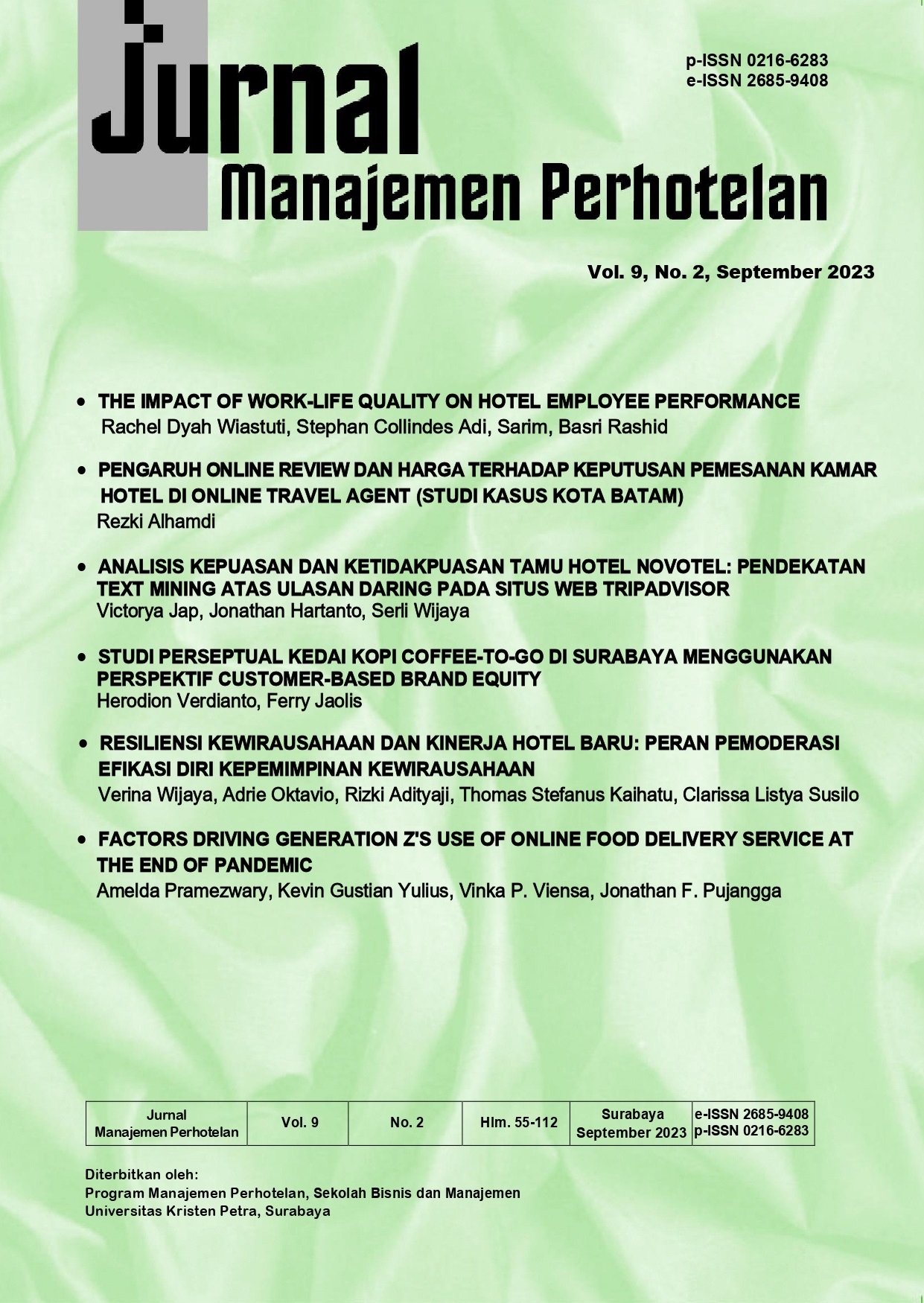ANALISIS KEPUASAN DAN KETIDAKPUASAN TAMU HOTEL NOVOTEL: PENDEKATAN TEXT MINING ATAS ULASAN DARING PADA SITUS WEB TRIPADVISOR
DOI:
https://doi.org/10.9744/jmp.9.2.71-80Keywords:
ulasan daring, kepuasan dan ketidakpuasan tamu, atribut hotelAbstract
Ulasan daring di internet merupakan gambaran perilaku pasca pembelian yang ditunjukkan oleh konsumen yang harus diperhatikan oleh bisnis di semua sektor termasuk perhotelan. Ulasan daring menjadi sarana bagi tamu hotel membagikan pengalaman menginap dimana bagi manajemen, ulasan daring dapat digunakan sebagai alat bantu untuk mengevaluasi layanan yang diberikan oleh hotel. Penelitian ini bertujuan untuk mengidentifikasi faktor penentu kepuasan dan ketidakpuasan tamu ketika menginap berdasarkan 7 atribut antara lain: hotel, service, room, food and beverage, location, security, dan price/value. Penelitian juga bertujuan mengukur konsistensi layanan yang diberikan hotel dengan brand name yang sama namun berlokasi di kota yang berbeda di Indonesia. Objek yang diteliti adalah lima properti hotel Novotel yang berada di Jakarta, Bandung, Surabaya, Semarang, dan Bali. Text mining dilakukan atas 1.229 ulasan daring menggunakan platform daring Voyant Tools. Hasil penelitian menemukan bahwa hotel Novotel telah konsisten dalam menjalankan SOP terkait kualitas produk dan layanannya. Atribut service menjadi atribut utama penyebab kepuasan dan ketidakpuasan tamu.
References
Accor (2021). Annual financial report integrated re-port. Retrieved 10 October 2022 from https://group.accor.com/en/finance.
Agnes, P. (2020). Pengaruh persepsi harga terhadap minat membeli di The 8th Restaurant and Lounge The Trans Luxury Hotel Bandung [Doctoral dis-sertation]. Sekolah Tinggi Pariwisata Sahid Sura-karta.
Chen, C. M., Yang, H. W., Li, E. Y., & Liu, C. C. (2015). How does hotel pricing influence guest satisfaction by the moderating influence of room occupancy?. International Journal of Hospitality Management, 49, 136-138. https://doi.org/10.1016/j.ijhm.2015.06.006
Gretzel, U., & Yoo, K. H. (2008). Use and impact of online travel reviews. Information and Commu-nication Technologies in Tourism, 35–46. Springer, Vienna. https://doi.org/10.1007/978-3-211-77280-5_4
Gunasekar, S., & Sudhakar, S. (2019). How user-generated judgments of hotel attributes in-dicate guest satisfaction. Journal of Global Scholars of Marketing Science, 29(2), 180-195. https://doi.org/10.1080/21639159.2019.1577155
Indra, S. R., & Damania, V. S. (2021). A study on changes in SOP’s (Standard Operating Proce-dures) Post-COVID-19 in core departments of 5 star hotels in Mumbai. Local Food and Commu-nity Empowerment Through Tourism, 2, 158-176. Eureka Publication: Mumbai.
Kim, D., & Perdue, R. R. (2013). The effects of cog-nitive, affective, and sensory attributes on hotel choice. International Journal of Hospitality Management, 35, 246-257. doi:10.1016/j.ijhm.2013.05.012
Kim, W. G., & Park, S. A. (2017). Social media review rating versus traditional customer satisfaction. In-ternational Journal of Contemporary Hospitality Management, 29(2), 784-802. https://doi.org/10.1108/IJCHM-11-2015-0627
Kuhzady, S., & Ghasemi, V. (2019). Factors influenc-ing customers' satisfaction and dissatisfaction with hotels: A text-mining approach. Tourism Analysis, 24(1), 69-79. https://doi.org/10.3727/108354219X1 5458295631972
Lee, J., Park, D., & Han, I. (2008). The effect of negative online consumer reviews on product atti-tude: An information processing view. Electronic Commerce Research and Applications, 7(3), 341-352. doi:10.1016/j.elerap.2007.05.004
Miller, A. (2018). Text mining digital humanities pro-jects: Assessing content analysis capabilities of Voyant Tools. Journal of Web Librarianship, 12(3), 169-197. https://doi.org/10.1080/19322909.2018.1479673
Mirzaalian, F., & Halpenny, E. (2019). Social media analytics in hospitality and tourism. Journal of Hospitality and Tourism Technology, 10(4), 764-790. doi:10.1108/jhtt-08-2018-0078
O'Connor, P. (2010). Managing a hotel's image on TripAdvisor. Journal of Hospitality Marketing & Management, 19(7), 754-772. https://doi.org/10.1080/19368623.2010.508007
Park, H., Lee, M., & Back, K. (2020). Exploring the roles of hotel wellness attributes in customer satis-faction and dissatisfaction: Application of kano model through mixed methods. International Journal of Contemporary Hospitality Manage-ment, 33(1), 263-285. https://doi.org/10.1108/IJCHM-05-2020-0442
Pizam, A., Shapoval, V., & Ellis, T. (2016). Customer satisfaction and its measurement in hospitality en-terprises: A revisit and update. International Journal of Contemporary Hospitality Management, 28(1), 2-35. https://doi.org/10.1108/IJCHM-04-2015-0167
Sampsel, L. J. (2018). Voyant tools. Music Reference Services Quarterly, 21(3), 153-157. https://doi.org/10.1080/10588167.2018.1496754
Thung, M. F., Tjahjowidodo, B. T., & Wijaya, S. (2021). Analisis kepuasan tamu hotel bintang 2 dan bintang 5 di Surabaya: Penerapan proses text-mining atas ulasan daring tamu. Jurnal Manajemen Pemasaran, 15(1), 1-9. https://doi.org/10.9744/pemasaran.15.1.1-9
Xiang, Z., Du, Q., Ma, Y., & Fan, W. (2017). A com-parative analysis of major online review plat-forms: Implications for social media analytics in hospitality and tourism. Tourism Management, 58, 51-65.
Xie, K. L., Chen, C., & Wu, S. (2015). Online con-sumer review factors affecting offline hotel popularity: Evidence from Tripadvisor. Journal of Travel & Tourism Marketing, 33(2), 211-223. https://doi.org/10.1080/10548408.2015.1050538
Xu, X., & Li, Y. (2016). The antecedents of customer satisfaction and dissatisfaction toward various types of hotels: A text mining approach. Interna-tional Journal of Hospitality Management, 55, 57-69. https://doi.org/10.1016/j.ijhm.2016.03.003
Xu, X., Wang, X., Li, Y., & Haghighi, M. (2017). Business intelligence in online customer textual reviews: Understanding consumer perceptions and influential factors. International Journal of Information Management, 37(6), 673-683. https://doi.org/10.1016/j.ijinfomgt.2017.06.004
Yang, W., & Mattila, A. S. (2012). The role of tie strength on consumer dissatisfaction responses. International Journal of Hospitality Manage-ment, 31(2), 399-404. doi:10.1016/j.ijhm.2011.06.015



















